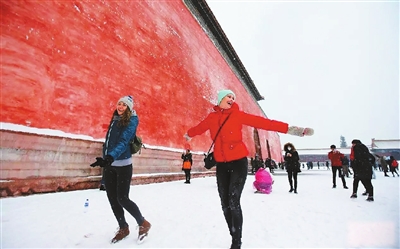
THE weather growing colder day by day elicits scenes of snowflakes drifting down from the gray sky above in our mind’s eye, encouraging a desire to frolic in a white wonderland. For those living in South China, who are usually easily enraptured by the rare sight of snow, the notion of a romantic getaway to a frosty haven with a cozy date can be realized all around China. Here’s a list of the places for seasonal winter scenery in China that are sure to take your breath away. Ice crystal wonderland in Jilin The beautiful rime countryside is the mesmerizing force pulling tourists to the frigid northeastern province of Jilin each winter. Located in Wulajie Manchu Town in the north of Jilin, Wusong Island is a small island on the Songhua River. It is the best-known scenic spot in China for its beautiful rime-encased scenery, opaque coatings of ice particles that crystallize on tree branches. The pristine white rime that adorns the landscape in winter is considered one of the four natural wonders of China and can be seen along the bank of the Songhua River running through the province. The other three natural wonders are the Stone Forest in Yunnan, the mountain landscapes of Guilin and the Three Gorges of the Yangtze River. The water in the Songhua River stays unfrozen in wintertime, continuously generating water vapor. As the water droplets splash onto nearby trees, they freeze and solidify, forming rime. The silver rime on the branches sways and shines under the sun alongside the river breeze. Changbai Mountain Changbai Mountain in winter presents a most beautiful masterpiece of a landscape to tourists when its dramatic peaks, placid lakes, dense forests and expansive grasslands are all covered with a blanket of white snow. Radiant scenery, hot springs, vast ski resorts and smaller crowds make it a perfect place to spend winter holidays. Located in the southeast of Baishan City in Jilin, Changbai Mountain is the highest mountain in the territory of Northeast China. It spans the border between China’s Jilin Province and North Korea and takes its Chinese name from the color of the winter snow and the white volcanic pumice scattered on its slopes. Here at Changbai Mountain, when looking ahead, one’s vision is filled with a vast silver wonderland of forests and lakes. The tranquil villages nestled in the depth of Changbai Mountain also attract many shutterbugs travelling from afar to record their meeting with the natural beauty here. Beiji Village, China’s ‘Arctic Village’ In winter, snow drifts down quietly on China’s northernmost village of Beiji, which is located at the northernmost tip of Mohe County and is the best location for observing aurora borealis in the country. Little wooden cottages are all covered by thick snow in winter. Orange light emanating from windows adds a touch of warmth to the crisp winter air, while bright stars twinkle clear and white against a dark blue sky. Apart from the whistling wind, all that can be heard is “yo-heave-ho” and the continuous sound of bells ringing, hanging down from around the necks of horses. About 10 minutes from the northern-most latitude in China, this place isn’t just a box to tick off for the adventurous traveler. During the winter, the thick blanket of snow and picturesque village label it a winter hide away. Snow scenery in the Forbidden City The Forbidden City was the Chinese imperial palace from the Ming Dynasty to the end of the Qing Dynasty — the years from 1420-1912. Located in the center of Beijing, it now houses the Palace Museum. It is one of the largest and best-preserved palace complexes in the world and was designated as a UNESCO World Cultural Heritage Site in 1987. After snow falls over the capital city, the Forbidden City embraces a striking winter look. Red walls, white snow and glazed tiles give a poetic new look to the ancient architecture in wintertime. Dagu Glacier About 280 km from Chengdu, the beautiful glacier of Dagu is known as the lowest, largest and youngest glacier in the world. Located at Heishui County, Sichuan, it is one of the rarely seen mountain glaciers. The top of Dagu Mountain is covered by snow all year round, presenting a gorgeous view under the golden sunlight. Standing at the top of the glacier, you can see the most stunning view of the rolling snow-capped mountains. The colorful prayer flags — which are a unique and often-seen sight in Tibetan region — add a sacred touch to the astonishing view. (Chen Xiaochun) | 
